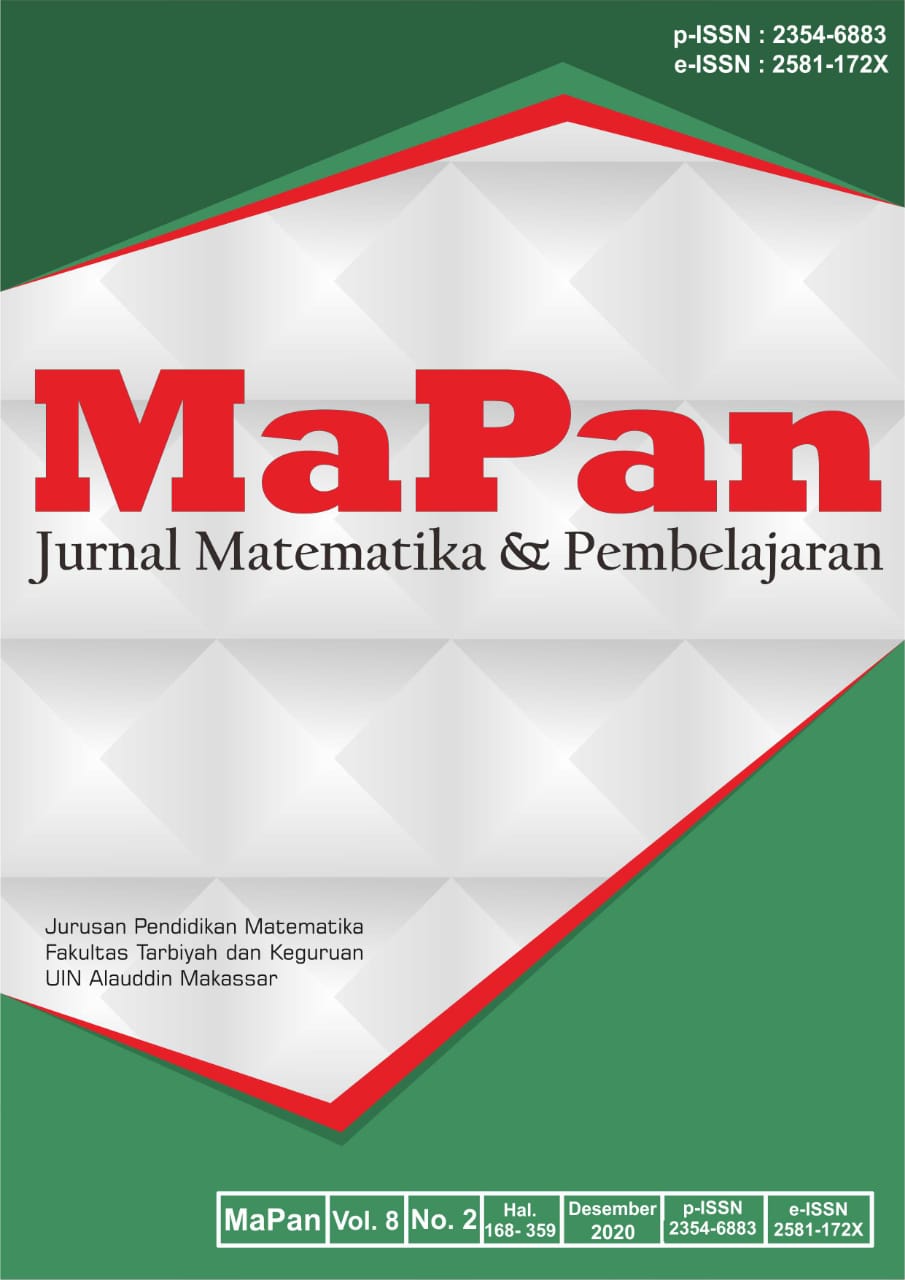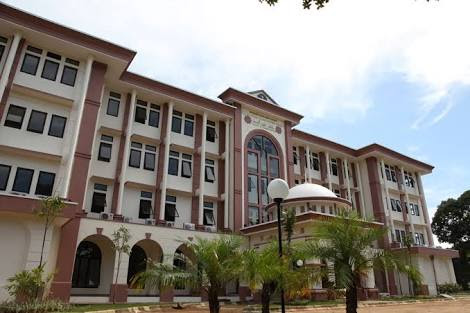THE DEVELOPMENT OF JUNIOR HIGH SCHOOL MATHEMATICS LEARNING TOOLS USING REALISTIC MATHEMATICS EDUCATION APPROACH TO RELATIONS AND FUNCTIONS MATERIAL
Abstract
This study aims to produce learning tools using Realistic Mathematics Education approach to relations and functions material. This type of research used the Plomp development model, which consists of three phases, namely the initial investigation phase, the development or prototyping phase, and the assessment phase. The research subjects were grade VIII students of SMPN 2 Takengon. The instruments of research are expert validation sheets, practicality assessment sheets, and effectiveness assessment sheets. The resulting tools include lesson plan, student books, teacher books, and student worksheets. The average assessment of the four aspects of the lesson plan was 3.89 with valid criteria. The average assessment of the three aspects of the teacher's book was 3.98 with valid criteria. The average assessment of three aspects of the student book was 3.97 with valid criteria. The average assessment of two aspects on the student worksheets was 3.75 with valid criteria. Learning implementation 96.86% and carried out well. The teacher's response showed that, on average, 82% of the lesson plan assessment aspects are responded positively by the teacher. The response of student books was obtained by 83.2% of students who gave positive responses to student books and 82.6% of students who gave positive responses to student worksheets. The students’ learning outcomes obtained a classical average value of 74.2. The results of validation and testing of learning tools show that the tools meet the criteria of learning tools developed, referring to valid, practical, and effective.
Downloads
References
Amin, S. M. (2014). The 2nd SEA-DR ISBN. Writing books on mathematics for primary school on A PMRI Approach, 1–6.
Aytekin, C., & Sahiner, Y. (2020). An investigation of preservice mathematics teachers’ teaching processes about “procedural and conceptual knowledge” related to division with fractions. Elementary Education Online, 19(2), 958–981. https://doi.org/10.17051/ilkonline.2020.695840.
Barnes, H. (2004). Realistic mathematics education: eliciting alternative mathematical conceptions of learners. African Journal of Research in Mathematics, Science and Technology Education, 8(1), 53–64. https:// doi.org/10.1080/10288457.2004.10740560.
Destino, M. D., & Bharata, H. (2019). Pengembangan bahan ajar transformasi geometri berorientasi pada kemampuan berpikir kritis siswa. 10(1), 57–67. https:/dx.doi.org/10.15294/kreano.v10i1.18493.
Fauzi, A., & Waluya, S. B. (2018). Math learning with realistic mathematics education approach (RME) based on open source - ended to improve mathematics communication. Journal of Primary Education, 7(1), 10–17. Retrieved from http://journal.unnes.ac.id/sju/index.php/jpe%0AMath.
Gee, E., Fauzan, A., & Atmazaki, A. (2018). Designing learning trajectory for teaching sequence and series using RME approach to improve students’ problem solving abilities designing learning trajectory for teaching sequence and series using RME approach to improve students’ problem solving ability. IOP Conf. Series: Journal of Physics, 1–6. https://doi.org/ 10.1088/1742-6596/1088/1/012096.
Gil-Domenech, D., & Berbegal-Mirabent, J. (2020). Making the learning of mathematics meaningful: an active learning experience for business students. Innovations in Education and Teaching International, 57(4), 403–412. https://doi.org/10.1080/14703297.2020.1711797.
Hadi, S. (2002). Effective teacher professional development for the implementation of realistic mathematics education in Indonesia. 454. Retrieved from http://doc.utwente.nl/58708/.
Hall, J., & Suurtamm, C. (2020). Numbers and nerds: exploring portrayals of mathematics and mathematicians in children’s media. International Electronic Journal of Mathematics Education, 15(3), em0591. https:// doi.org/10.29333/iejme/8260.
Hasibuan, A. M., Saragih, S., & Amry, Z. (2018). Development of learning materials based on realistic mathematics education to improve problem solving ability and student learning independence. International Electronic Journal of Mathematics Education, 14(1), 243–252. https://doi.org/ 10.29333/iejme/4000.
Inglis, M., & Attridge, N. (2016). Does mathematical study develop logical thinking?: testing the theory of formal discipline. Does Mathematical Study Develop Logical Thinking?: Testing the Theory of Formal Discipline, 1–185. https://doi.org/10.1142/q0020.
Khoshaim, H. B. (2020). Mathematics teaching using word-problems: Is it a phobia! International Journal of Instruction, 13(1), 855–868. https://doi.org/ 10.29333/iji.2020.13155a.
Marlinda, I., & Wijaya, A. (2018). Pengembangan perangkat pembelajaran dengan pendekatan pendidikan matematika realistik berorientasi pada minat dan prestasi developing a learning set with realistic mathematics education approach oriented to the interest and achievement. PHYTAGORAS: Jurnal Pendidikan Matematika, 13(1), 76–87. https://dx. doi.org/10.21831/pg.v13i1.21171.
Mauliana, Ikhsan, M., & Subianto, M. (2018). Development of learning tool with contextual teaching and learning (CTL) approach to improve student mathematical connection ability. Journal of Physics: Conference Series, 1088, 1–5. https://doi.org/10.1088/1742-6596/1088/1/012012.
Nababan, S. A. (2017). Pengembangan perangkat pembelajaran berbasis pendekatan RME untuk meningkatkan kemampuan berpikir kritis siswa sekolah dasar. Jurnal Pendidikan Matematika, 6(5), 24–36. Retrieved from https://ejournal.stkipbbm.ac.id/index.php/pgsd/article/download/1.
Ndiung, S. (2020). The treffinger learning model with rme principles on mathematics learning outcome by considering numerical ability. Advances in Social Science, Education and Humanities Research, 422(Icope 2019), 7–13. http://creativecommons.org/licenses/by-nc/4.0/.
Nieveen, N. (1999). Prototyping to reach product quality Nienke. In Design Approaches and Tools in Education and Training. https://doi.org/10.1007/ 978-94-011-4255-7.
Plomp, T. (SLO), & Nieveen, N. (SLO). (2013). Educational design research educational design research. Educational Design Research, 1–206.
Putri, S. K., Hasratuddin, H., & Syahputra, E. (2019). Development of learning devices based on realistic mathematics education to improve students’ spatial ability and motivation. International Electronic Journal of Mathematics Education, 14(2), 375–383. https://doi.org/10.29333/iejme/ 5729.
Rasmussen, C. L., & King, K. D. (2000). Locating starting points in differential equations: a realistic mathematics education approach. International Journal of Mathematical Education in Science and Technology, 31(2), 161–172. https://doi.org/10.1080/002073900287219.
Rochmad. (2012). Desain model pengembangan perangkat pembelajaran matematika. Jurnal Kreano, 3(1), 59–72. https://doi.org/10.15294/kreano. v3i1.2613.
Sembiring, R. K., Hadi, S., & Dolk, M. (2008). Reforming mathematics learning in Indonesian classrooms through RME. ZDM - International Journal on Mathematics Education, 40(6), 927–939. https://doi.org/10.1007/s11858-008-0125-9.
Sitorus, J., & Masrayati. (2016). Students’ creative thinking process stages: implementation of realistic mathematics education. Thinking Skills and Creativity, 22, 111–120. https://doi.org/10.1016/j.tsc.2016.09.007.
Wibowo, T. H. (2020). Penerapan Bahan ajar matematika berbasis realistic mathematics education. 1(2), 62–65. https://doi.org/10.37251/ijoer.v1i2.93
Zulkardi, Z., Putri, R. I. I., & Wijaya, A. (2020). Two decades of realistic mathematics. Springer International Publishing. https://doi.org/10.1007/ 978-3-030-20223-1.
Copyright (c) 2020 Julia Noviani, Firmansyah

This work is licensed under a Creative Commons Attribution 4.0 International License.


